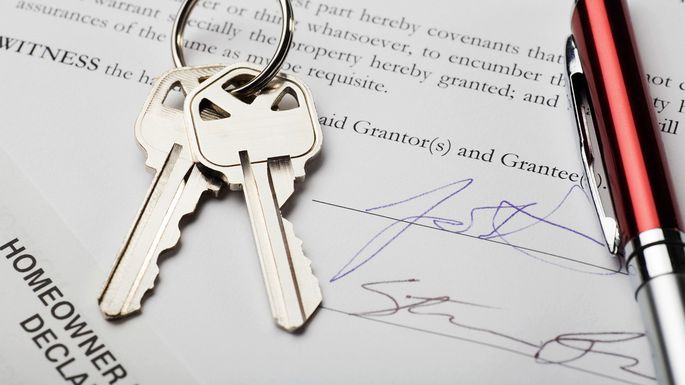Ah, closing on a house. It’s the finish line! You’re almost home free (or free of your home in this case). You’ve accepted the buyer’s offer, the negotiations are finally winding down, and there is only one more little box to check: closing.
OK, so maybe it isn’t a little thing. And maybe you’re a little bit worried something is still going to go wrong when closing on a house. That’s why we’re here to help get you through closing without a hitch—or barely a hitch (hey, stuff happens).
Get the repairs done
First things first: You’ve got to get those repairs done before closing on a house. We get it—the last thing you want to do now is work on a house you are about to sell. But if you agreed to make repairs or improvements, don’t put them off until the last minute.
“Some sellers do try to get cute and wait until the day of closing, but they really should do all the repairs at least a week before closing,” says Joshua Jarvis, founder of Jarvis Team Realty in Duluth, GA. Getting things done ahead of time will give you plenty of wiggle room if something should still go wrong, or if the buyer finds a problem during the final walkthrough (more on that to come).
So check the approved offer, make a note of any repairs you and the buyer agreed on, and get to it—and don’t forget to cover yourself. Save receipts from items purchased and invoices from contractors, and take before and after photos of any work completed. You will have proof that repairs were completed on the off chance that the buyers contest them during the walkthrough or at closing.
The final walkthrough
Before your closing date—often 24 hours before—the buyers and the buyers’ agent will do one more walkthrough of the house (for which you should not be present). They will go through every room of the house, inside and outside—a process that typically takes about a half hour. Some buyers will go into detail, testing every light switch. But in most cases, the buyer is just looking to make sure agreed-upon repairs were made and no new issues have crept up before closing.
“Buyers are basically looking for anything unexpected in the home,” Jarvis says. “Say, for example, there was a rug covering a problem area.” (Not that you would do that, you awesome seller, you.) If the buyers do find an issue, you may have a chance to fix the problem ahead of time.
“In most cases, the seller would be notified immediately after the walkthrough,” Jarvis says.
If the problem is big enough, you may have to delay your closing date to give time for the repair. But that only happens occasionally. Often, the buyers will take a trade.
“Many times, the buyers ask for money instead,” Jarvis says. But once the documents are ready to go, the terms usually can’t be altered to include the new amount, and that is where the trade comes in. “You typically see gift cards or appliance trades [added to the deal],” Jarvis says.
Closing on a house officially
Many closings go smoothly. By this point, the buyers are excited to get into their new house, agreed-on repairs have been made, and the sellers are ready to get out. If things are going smoothly, the closing for you might boil down to a blur of paperwork. “The sellers sign eight documents and will have to sit through an hour and a half of watching the buyer sign,” Jarvis says.
Unless problems creep up—or the buyer wants to negotiate further—you only have two jobs: waiting and reading documents. Some are worth perusing more than others. For example, make sure you pay close attention to the settlement statement. “There are other documents you’ll need to sign like a warranty deed or ‘Don’t sue the attorney’ documents, but the settlement is the most important,” Jarvis says. It includes the money you’re making on the sale, plus tax implications. Make sure to check that these numbers jibe with what you’ve been told and were expecting—and if not, pull your real estate agent or attorney aside and point them out.
Last-minute drama
So what if things aren’t going smoothly? What if the buyers want to negotiate again? The buyer has the right to hash out concerns up until the time they sign the final document and take possession of your house. It makes sense to at least hear them out. After all, you’ve come this far.
If the buyer is negotiating for something you can solve without amending the terms (say, for example, you can offer up the washer and dryer in the house), you’ll probably be able to hammer those details out at closing.
But if you and the buyer have negotiated a lower price at the last minute, you may have to delay closing.
“Big changes just mess the whole thing up,” Jarvis says. “For example, a seller could say, ‘I’ll drop the price by $2,000.’ There’s an amendment that needs to be done and the the loan would have to be rerun,” Jarvis says. That could take anywhere from one day to a week, depending on the bank’s turnaround times.
Once the negotiations are handled and the papers are signed, the buyers’ funds are transferred to your attorney, who will handle the payments to cover your loan and pay your real estate team. Thankfully, this part is handled by someone else.
And then comes the best part: You’ll get a check for the remainder, usually the same day in most states.
Now, all that’s left is the fun part: Officially moving out and moving on!
Original article found at: https://www.realtor.com/advice/sell/what-to-expect-at-the-closing/

